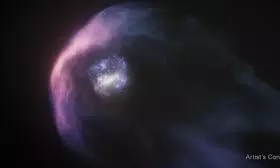
Milky Way’s ‘cosmic hairdryer’ strips mass from neighboring galaxy
text_fieldsNASA's Hubble Space Telescope has unveiled a dramatic interaction in the outskirts of the Milky Way, where our galaxy is reshaping its smaller neighbor, the Large Magellanic Cloud (LMC).
This dwarf galaxy, about 20 times the apparent size of the full Moon, has experienced significant loss of its outer gas halo due to the Milky Way's powerful forces, akin to a "cosmic hairdryer," according to scientists.
Contrary to previous beliefs that the LMC orbits the Milky Way, researchers now suggest it is merely passing by. However, its close encounter with the Milky Way has resulted in a phenomenon called ram pressure. This occurs when the dense environment of the Milky Way exerts intense pressure, stripping away much of the LMC's spherical gas halo and leaving behind only a compact remnant.
“The Milky Way is like a giant hairdryer blowing gas off the LMC as it approaches,” explained Andrew Fox of the European Space Agency in Baltimore, who led the Hubble observations. "What remains is a smaller, compact halo trailing the galaxy like the tail of a comet."
Despite this substantial loss, the LMC has endured the cosmic forces and retains enough gas to form new stars. Fox emphasized the resilience of the galaxy, stating, “The LMC is a survivor. It still has enough material to create star-forming regions, ensuring its ability to generate new stars.”
The LMC’s mass, approximately 10% that of the Milky Way, plays a crucial role in its survival. Its heftier build compared to most dwarf galaxies has enabled it to hold onto some of its gas and maintain gravitational integrity. A less massive galaxy in its position might have been stripped entirely, leaving behind only aging stars.
As the LMC moves away from its closest point to the Milky Way, scientists believe it will retain the remaining portion of its halo, though the stripped gas will eventually rain into the Milky Way. This ongoing interaction underscores the dynamic nature of galaxy evolution and provides astronomers with a rare glimpse into the complex forces shaping the universe.


















